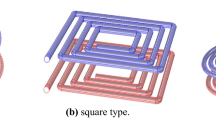Abstract
In magnetic resonance coupled wireless power transfer (WPT) systems, parameters were investigated in the WPT system to ensure maximum power transfer under the conditions of changing the distance between the receive coil and the transmit coil. When the distance between the transceiver coils is changed, the inductances of the system and the coupling coefficient for maximum power transfer were calculated with Maxwell-3D, which performed a solution based on the finite element method (FEM). In addition, the effect of the distance variation between the transmitter and receiver coils, the coupling coefficient (k) values, on the input inductance and power transmission was investigated. In the model developed in the ANSYS-Maxwell environment, it has been observed that the variation of the input inductance depending on the distance and therefore the common inductance between the transmitter and receiver coils can be analyzed. In addition, the effect of the coupling factor (k) on the WPT system has also been demonstrated. It has been shown that maximum power transfer can be sustained in WPT systems where the distance between the receive coil and the transmit coil varies within certain limits. Finally, the efficiency of the transformer for a close distance between the coils was also tested experimentally.
Similar content being viewed by others
Abbreviations
- A:
-
area, m2
- λ :
-
flux
- ϕ :
-
vector potential
- k :
-
coupling coefficient
References
Hong, W., Lee, S. and Lee, S. H. (2022). Sensorless control of series–series tuned inductive power transfer system. IEEE Trans. Industrial Electronics 70, 10, 10578–10587.
Hui, S. Y. R., Zhong, W. and Lee, C. K. (2013). A critical review of recent progress in mid-range wireless power transfer. IEEE Trans. Power Electronics 29, 9, 4500–4511.
Inoue, R., Nagasaki, Y., Tsuda, M. and Miyagi, D. (2022). Basic coil structure for rapid charge in a low-frequency and high-efficiency wireless power transmission system using high-temperature superconducting coil for railway vehicle. IEEE Trans. Applied Superconductivity 33, 1, 1–9.
Jeong, S., Kim, T. W., Lee, S., Sim, B., Park, H., Son, K., Kim, S., Shin, T., Kim, Y. C., Kim, J. and Kim, B. J. (2022). Analysis of repetitive bending on flexible wireless power transfer (WPT) PCB coils for flexible wearable devices. IEEE Trans. Components, Packaging and Manufacturing Technology 12, 11, 1748–1756.
Kurs, A., Karalis, A., Moffatt, R., Joannopoulos, J. D., Fisher, P. and Soljacic, M. (2007). Wireless power transfer via strongly coupled magnetic resonances. Science 317, 5834, 83–86.
Mukundan, N., Sangeetha, V., Jayaprakash, P., Asokan, O. V., Al-Durra, A., Zeineldin, H. and EL-Fouly, T. H. (2022). A new multilevel inverter based grid connected reliable solar power transfer unit with power quality enhancement. IEEE Trans. Industry Applications 59, 2, 1887–1900.
Wang, H. and Cheng, K. W. E. (2022). A special magnetic coupling structure design for wireless power transfer systems. IEEE 20th Biennial Conf. Electromagnetic Field Computation (CEFC), Denver, Colorado, USA.
Wong, C. S., Liu, J., Cao, L. and Loo, K. H. (2022). A SWISS-rectifier-based single-stage three-phase bidirectional AC–DC inductive-power-transfer converter for vehicle-to-grid applications. IEEE Trans. Power Electronics 38, 3, 4152–4166.
Yahya, S. I., Alameri, B. M., Jamshidi, M., Roshani, S., Chaudhary, M. A., Ijemaru, G. K., Mezaal, Y. S. and Roshani, S. (2022). A new design method for class-E power amplifiers using artificial intelligence modeling for wireless power transfer applications. Electronics 11, 21, 3608.
Author information
Authors and Affiliations
Corresponding author
Additional information
Publisher’s Note Springer Nature remains neutral with regard to jurisdictional claims in published maps and institutional affiliations.
Rights and permissions
About this article
Cite this article
Özüpak, Y. Analysis of the Parameters Affecting the Efficiency of the Wireless Power Transmission System Designed for New Generation Electric Vehicles. Int.J Automot. Technol. 24, 1675–1680 (2023). https://doi.org/10.1007/s12239-023-0135-1
Received:
Revised:
Accepted:
Published:
Issue Date:
DOI: https://doi.org/10.1007/s12239-023-0135-1




